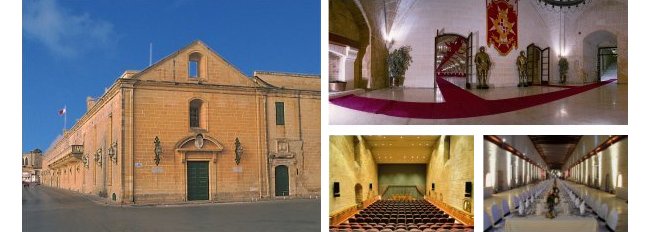Meeting Location
The 2006 meeting of the ESF Research Networking Programme EIPAM will be held at the
Mediterranean Conference
Centre, Valletta, Malta.

The building was originally the hospital or "Sacra Infermeria" of the
Order of St John. It was constructed in 1574 under Grand Master Jean de la
Cassiere and achieved fame as one of the foremost hospitals of the period
in Europe. Food was served by the Knights themselves on silver plates,
specimens of which, together with ceramic pharmacy jars, may be seen at
the National Museum of Fine Arts. The restoration and conversion of this
edifice into a first-call conference centre in 1976 won the "Europa Nostra
Award" for Malta. The Exhibition Hall, formerly the Great Ward of the
hospital, which measures 161 meters long, is believed to be one of the
longest halls in Europe. The main conference hall, seating 1,400 people
was destroyed by fire in 1987 and has since been rebuilt.
Local Currency
The Currency on Malta is the Maltese Pound Liri - abbreviated as the
LM.
Each Maltese Liri is divided into 100 cents.
At present : 1 Maltese Lm = 2.33 Euros or 1.60 UK pounds or 2.80 US
dollars
Valletta – The fortress City of The Mediterranean
Set at the crossroads of the Mediterranean, Valletta is one of the best
preserved fortified cities in the world and one of the architectural
showpieces of Europe. It was built by the Knights of St John immediately
after the Great Siege of 1565, during which the vastly outnumbered knights
turned back the might of the hitherto invincible Ottoman Empire and thus
arguably saved Western Europe. Riches poured into Malta from grateful
courts across the continent and much of this went into constructing the
new city. The Turks never returned but in 1942 Malta once again took a
fearful pounding from a vastly superior force – the German Luftwaffe. Once
again it held firm and thus helped shape world events for a second time in
its history.
As cities go, Valletta is minute. It measures less than one square
kilometre and you can walk across its widest point in less than 20
minutes. Within that space, however, shady atmospheric alleyways link
grand squares, and glorious Baroque palazzi sit alongside bars and shop
fronts that have hardly changed in over a century. You’ll need good
walking shoes and sturdy legs to explore as there are hundreds of steps
and the only real way to get around is on foot. The city occupies a
promontory, is enclosed by mighty bastions and curtain walls, and boasts
magnificent sea views. In contrast to the tiny metropolis, Grand Harbour,
until quite recently home to the British Navy, is the biggest, and
arguably the most impressive harbour in all the Mediterranean.
| 
